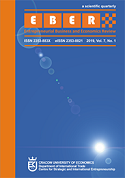How to increase the value of bilateral trade? Currency union versus fixed exchange rate regime
How to increase the value of bilateral trade? Currency union versus fixed exchange rate regime
Author(s): Oleksandra Ivanievna StoykovaSubject(s): Economic policy, International relations/trade, Financial Markets
Published by: Uniwersytet Ekonomiczny w Krakowie
Keywords: fixed exchange rate; currency union; trade integration; Optimum Currency Area; exchange rate regimes ;
Summary/Abstract: Objective: The objective of the article is to determine which exchange rate regime provides higher bilateral trade: fixed rate or currency union. Research Design & Methods: An index was designed based on variables commonly recognised as those that might affect the value of bilateral trade and those that are differently affected by fixed exchange rate regime and currency union. These variables are trade openness, trading partner trade importance, similarities of government debt and borrowing, similarities of inflation, and the correlation coefficient of detrended GDP. The index serves as a dependent variable in the main model, which was created using principal component analysis. I also ran models with both trade openness and trading partner trade importance as dependent variables. Findings: Although the index appeared to be higher in countries with a currency union, the results show that a currency union does not provide higher values of bilateral trade compared to a fixed exchange rate regime. Implications & Recommendations: Research can be repeated with more attention dedicated to independent variables. Alternative de facto classifications of exchange rate regimes can be used for future studies as well. Contribution & Value Added: The article contributes to existing studies on exchange rate regimes that commonly and interchangeably use notions of fixed exchange rate regime and currency union. To my best knowledge, there is no previous empirical research that would separately compare the impact on trade of these notions. The current study fills this gap.
Journal: Entrepreneurial Business and Economics Review
- Issue Year: 9/2021
- Issue No: 2
- Page Range: 21-38
- Page Count: 18
- Language: English

